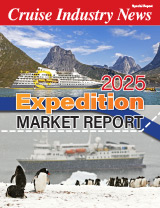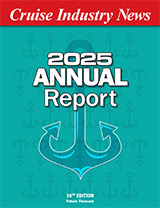Carnival Corporation has reported net income of $127.9 million, or $0.22 per share, on revenues of $1,007.6 million for its first quarter ended February 28, 2001, compared to net income of $171.5 million, or $0.28 per share, on revenues of $824.9 million for its first quarter of 2000.
In a conference call to analysts, Carnival executives attributed the results to several factors, but mainly to the continued pressure on pricing, the unusually high ticket prices achieved for last year’s Millennium cruises, losses at Airtours and Costa Crociere, and to Cunard Line, which continued to be a “challenge.”
Costa is consolidated into Carnival’s report, while Airtours’ contribution is a line item as an affiliated operation. Carnival holds a 26 percent interest in Airtours.
According to Carnival, Costa’s results were impacted by the Costa Classica being out of service and the seasonality of that brand’s business. In addition, Costa’s average per diem is lower than the other Carnival brands, according to Howard Frank, vice chairman and CFO of Carnival.
Airtours’ losses were attributed to the costs of expansion into the German market and a one-time write-off from closing 120 travel agencies in the U.K. “We are pleased with the contemporary and premium (market) segments,” said Frank. “But the luxury segment came in lower than we expected.”
Forward Looking
Frank said that Carnival expected to see improvement in cruise operating profits starting in the second quarter. But he also said that the second quarter would be impacted by Airtours as well as by higher interest costs year-over-year from the acquisition debt for Costa.
Looking back on the winter months, Frank said: “This is the strongest wave season we have ever experienced.” While he said that Carnival “is encouraged,” he cautioned that he was concerned with the softening of the economy.
Carnival notably cited forecasts up slightly or flattish for the balance of the year, excluding Costa.
The mass market has also shown the greatest resiliency to the weakening economy, according to Frank.
Cunard will be reorganized into its original two brands, Cunard Line and Seabourn Cruise Line, with sales and marketing headed up by Debbie Nathansohn and Rick Meadows, respectively. There will thus be separate brand management responsible for filling the ships at acceptable per diems, Frank noted, something which apparently had been missing in the previous organizational set-up.
The synergies will be found in the back office operations.
Pam Conover remains as president and COO.
Implementing changes, however, takes time and Frank said he was hopeful for a positive development at Cunard starting in 2002.
Looking further out, Carnival Chairman Micky Arison said he expected more ship movements in the future by all the lines. He cited Princess Cruises, which is moving ships from its North American operations to Europe; Star Cruises, which is moving ships from the Far East to Norwegian Cruise Line; and Carnival Cruise Lines, which moved the Tropicale to Costa.
“We are looking at putting our assets where it makes the most sense,” he said.
Arison also noted that there seemed to be trading down in the market, whereby passengers would trade from a $20,000 Mediterranean cruise on Seabourn to a $5,000 cruise on Holland America Line (HAL). “I cannot say if the trading goes further down,” he added.
Windstar Cruises has been seeing some of the same, Arison noted. “But they have lower pricing so I think they (Windstar) will be fine.”
Arison also pointed out that the luxury market represents less than nine percent of the company’s overall business.
For those analysts who follow the industry, recommendations ranged from a Buy to a Strong Buy with forecasted earnings per share of approximately $1.75 for 2001 and a stock price in an optimistic range from the mid to high $30s to low $40s.
At press time, Carnival was listed at $27.60 on the New York Stock Exchange.
Seabourn Sun Moves to HAL
Only two days after the conference call, Seaboum announced that the Seaboum Sun, the former Royal Viking Sun, will be reassigned to the HAL fleet.
The 1988-built, 38,000-ton, 758-passenger Seaboum Sun will be transferred as soon as she completes her around-the-world voyage in April 2002.
Thus, Seabourn will be able to focus on its remaining fleet, comprised of the two original Seabourn vessels and the one similar Royal Viking Line 212-passenger ship plus the two smaller 110-passenger former Sea Goddess yacht-like vessels.
It is unclear, however, how the Seabourn Sun will fit into the HAL mold, with that company is building ever larger ships to gain economic efficiencies, and selling off its older vessels.
It is also surprising that the Seabourn Sun was not transferred to the Cunard brand where she could have sailed alongside the Caronia, the renamed Vistafjord.
Westerdam to Costa
This past week, Carnival Corporation also announced that HAL’s 1,494-passenger Westerdam will be transferred to Costa after finishing the 2002 winter Caribbean season.
Thus, the Westerdam will be the second Carnival Corp. vessel transferred to Costa over a 14 month period. Last month, the Tropicale joined the Costa fleet.
Both ships will sail seven-day summer programs in the Mediterranean. Winter itineraries have not been announced yet.
The Westerdam was built for Home Lines in 1986 as the 1,000-passenger Homeric. HAL subsequently acquired Home Lines and stretched the Homeric to accommodate 1,494 passengers.
Implications
The ship movements serve to demonstrate how competitive the market is. If these ships were sailing full and making money, clearly, they would not be leaving.
On the positive side, the Carnival brands that sell off older tonnage are left with larger and more efficient ships which are inherently more profitable.
The challenge, however, will lie in Costa’s court. Already, the Italian operator’s per diems are below the average of the other Carnival brands, according to Carnival, so how will Costa be able to fill all the ships, especially the older ships, and raise per diems at the same time. If not, Costa will continue to drag down Carnival Corporation’s per diems.
Thus, while Carnival Cruise Lines and HAL appear to be doing well, the company is faced with turning Cunard and Seabourn around – while also integrating an $800 million ship (QM2) profitably in the Cunard fleet – as well as raising Costa’s contributions. Meanwhile, there are also indications that Carnival is becoming impatient with Airtours’ negative impact on its earnings.
So what does all this mean? That a lot more changes may be in the store at Carnival Corporation - sooner rather than later.



